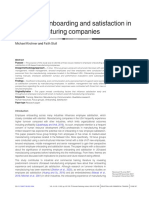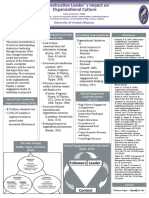Training_Underperformance
Uploaded by
rizminTraining_Underperformance
Uploaded by
rizminTraining as a Mechanism to Overcome Underperformance
There are many reasons behind the underperformance of the employees, which include
skill gaps, lack of motivation, or unclear expectations and guidance. To address this
issue, the organization should have proper mechanisms to manage the human capital by
analyzing the training needs. as per Dhamasiri's (2012) 7G framework, GROW is the
main perspective for developing people to equip employees with the necessary skills,
knowledge, and confidence to maintain the competitive advantage of the organization.
Relevance of Training
1. Addressing Skill Gaps
One of the main reasons we can say is that the lack of manpower skills causes
underperformance. Providing proper technical and behavioral skills training will fill these
gaps which they required to perform any task. For example, a sales team struggling to
reach their target may be the skill gap focusing on advanced sales techniques used and
customer relationship management. These issues can be resolved by conducting relevant
training; such training not only improves their competence but also enhances the
confidence of the sales team to handle challenging situations.
2. Enhancing Motivation and Engagement
Training can also serve as a motivational tool. Employees who feel invested in through
training perceive themselves as valued members of the organization. For example, a
company offering leadership development programs to high-potential employees
demonstrates its commitment to their growth, which in turn fosters loyalty and
engagement. Motivated employees are more likely to overcome underperformance and
contribute positively to organizational goals.
3. Clarifying Expectations and Processes
Another reason for underperforming is unclear expectations or processes. The figure
below explains the advantages of onboarding training over time. Onboarding training
provides benefits to understanding the organizational culture, roles and responsibilities,
System used, Health and safety requirements, other codes of conduct, legal requirements,
etc. For instance, an onboarding program that includes training on company policies,
tools, and workflows ensures that new employees start their roles with a clear
understanding of what is expected of them.
Productivity With Onboarding
Benefit
Without Onboarding
4. Supporting Continuous Learning
The business world is changing rapidly, accordingly, people should be ready to face new
challenges. This is only possible by focusing on continuous learning; if we don’t get
ready, someone else will be replaced by the market. Continuous training maintains the
performance levels, upskill and reskill that will help them to adopt with the new
technologies and market demand. For example, a software development team might
undergo training on the latest programming languages to stay competitive and meet
project requirements effectively.
Conclusion
According to the above clarification training is essential for any organization to address
the underperformance by focusing employees with the skills, knowledge, and motivation
that they need to excel. This solution not only helps us to enhance the performance level
but also paves the way to motivate and engage them for future business development.
You might also like
- MBA 501 (MBA-17-4607) - Individual AssignmentNo ratings yetMBA 501 (MBA-17-4607) - Individual Assignment11 pages
- Manager's Toolkit: The 13 Skills Managers Need to SucceedFrom EverandManager's Toolkit: The 13 Skills Managers Need to Succeed4/5 (12)
- Train the Trainer: Unlock your potential as a professional trainerFrom EverandTrain the Trainer: Unlock your potential as a professional trainerNo ratings yet
- Summary of David H. Maister's Managing The Professional Service FirmFrom EverandSummary of David H. Maister's Managing The Professional Service FirmNo ratings yet
- Some Philippine Studies On Worker Motivation: Fernando W. de GuzmanNo ratings yetSome Philippine Studies On Worker Motivation: Fernando W. de Guzman17 pages
- Learning and Development: How To Close The Skills Gap in Your OrganizationFrom EverandLearning and Development: How To Close The Skills Gap in Your OrganizationNo ratings yet
- Fusion or Fizzle: How Leaders Leverage Training to Ignite ResultsFrom EverandFusion or Fizzle: How Leaders Leverage Training to Ignite ResultsNo ratings yet
- The Ultimate Employee Training Guide- Training Today, Leading TomorrowFrom EverandThe Ultimate Employee Training Guide- Training Today, Leading TomorrowNo ratings yet
- 51 Secrets of Successful Entrepreneurs: How To Thrive In Hard TimesFrom Everand51 Secrets of Successful Entrepreneurs: How To Thrive In Hard TimesNo ratings yet
- EVALUATING THE ROLE OF CORE COMPETENCIES IN IMPROVING PERFORMANCE OF MANUFACTURING INDUSTRIESFrom EverandEVALUATING THE ROLE OF CORE COMPETENCIES IN IMPROVING PERFORMANCE OF MANUFACTURING INDUSTRIESNo ratings yet
- Driving Success: A Strategic Approach to Employee Satisfaction and Organizational CommitmentFrom EverandDriving Success: A Strategic Approach to Employee Satisfaction and Organizational CommitmentNo ratings yet
- Supercharge Your Work Team Seven Steps To Create A High Performing TeamFrom EverandSupercharge Your Work Team Seven Steps To Create A High Performing TeamNo ratings yet
- interim management for beginners: exclusive insight for the interim manager of tomorrow. Well-founded. Instructive. Pioneering.From Everandinterim management for beginners: exclusive insight for the interim manager of tomorrow. Well-founded. Instructive. Pioneering.No ratings yet
- Taming the Terrible Too's of Training: How to improve workplace performance in the digital ageFrom EverandTaming the Terrible Too's of Training: How to improve workplace performance in the digital ageNo ratings yet
- Enhancing Your Organization's Learning Culture for Business Results: A Practical Guide For ManagersFrom EverandEnhancing Your Organization's Learning Culture for Business Results: A Practical Guide For ManagersNo ratings yet
- Examining Career Development within Learning Organisations: Career Development Book Series, #4From EverandExamining Career Development within Learning Organisations: Career Development Book Series, #4No ratings yet
- Running Training Like a Business: Delivering Unmistakable ValueFrom EverandRunning Training Like a Business: Delivering Unmistakable ValueNo ratings yet
- Developmental Leadership: Equipping, Enabling, and Empowering Employees for Peak PerformanceFrom EverandDevelopmental Leadership: Equipping, Enabling, and Empowering Employees for Peak PerformanceNo ratings yet
- Employee Development: Big Business Results on a Small Business BudgetFrom EverandEmployee Development: Big Business Results on a Small Business Budget5/5 (3)
- Training and Development Presentation: GROUP 1 MembersNo ratings yetTraining and Development Presentation: GROUP 1 Members62 pages
- Designing Training to Shorten Time to Proficiency: Online, Classroom and On-the-job Learning Strategies from ResearchFrom EverandDesigning Training to Shorten Time to Proficiency: Online, Classroom and On-the-job Learning Strategies from ResearchNo ratings yet
- The Positive Coach Approach: Call Center Coaching for High PerformanceFrom EverandThe Positive Coach Approach: Call Center Coaching for High PerformanceNo ratings yet
- MBA508 2 - Understanding the Financial StatementsNo ratings yetMBA508 2 - Understanding the Financial Statements8 pages
- MBA508 1 - The Role Function of AccountingNo ratings yetMBA508 1 - The Role Function of Accounting10 pages
- MBA501 Session 1 Introduction to Mgt HONo ratings yetMBA501 Session 1 Introduction to Mgt HO11 pages
- Assignment No -01 Management and OrganizationsNo ratings yetAssignment No -01 Management and Organizations12 pages
- MBA 501 Managing Organizations MBA 2022 Int final exam paper (1)No ratings yetMBA 501 Managing Organizations MBA 2022 Int final exam paper (1)1 page
- Master Time Table MBA 2024 (Oman) (updated on 20-01-2025)No ratings yetMaster Time Table MBA 2024 (Oman) (updated on 20-01-2025)1 page
- Ig6YFBITiWSdY28Ln3KQ_ObjectiveTargetsWaste-1570029632336No ratings yetIg6YFBITiWSdY28Ln3KQ_ObjectiveTargetsWaste-15700296323361 page
- Institute of Management, Nirma University: MBA (FB&E) - I: 2010-2012 Batch:: 2nd Term Class ScheduleNo ratings yetInstitute of Management, Nirma University: MBA (FB&E) - I: 2010-2012 Batch:: 2nd Term Class Schedule4 pages
- Psychosocial Work Stressors and Well-Being: Self-Esteem and Optimism As Moderators in A One-Year Longitudinal SampleNo ratings yetPsychosocial Work Stressors and Well-Being: Self-Esteem and Optimism As Moderators in A One-Year Longitudinal Sample21 pages
- Southeast University Southeast Business School Semester: Fall Year: 2020No ratings yetSoutheast University Southeast Business School Semester: Fall Year: 20205 pages
- Employee Onboarding and Satisfaction in US Manufacturing CompaniesNo ratings yetEmployee Onboarding and Satisfaction in US Manufacturing Companies12 pages
- HR HandBook Check List 2024 - HR Essential GuideNo ratings yetHR HandBook Check List 2024 - HR Essential Guide13 pages
- Health Post - Exploring The Intersection of Work and Well-Being - A Guide To Occupational Health PsychologyNo ratings yetHealth Post - Exploring The Intersection of Work and Well-Being - A Guide To Occupational Health Psychology3 pages
- Tybbi Sem V: Human Resource Management Mcqs100% (1)Tybbi Sem V: Human Resource Management Mcqs10 pages
- Download Complete (eBook PDF) Essentials of Organizational Behavior An Evidence-Based Approach 2nd Edition PDF for All Chapters100% (7)Download Complete (eBook PDF) Essentials of Organizational Behavior An Evidence-Based Approach 2nd Edition PDF for All Chapters46 pages
- Theories of Motivation and Their Application in Organisations A Risk Analysis PDFNo ratings yetTheories of Motivation and Their Application in Organisations A Risk Analysis PDF8 pages
- "Effectiveness of Traning and Development" at Pepsico Pvt. Ltd. FinalNo ratings yet"Effectiveness of Traning and Development" at Pepsico Pvt. Ltd. Final89 pages























































































































